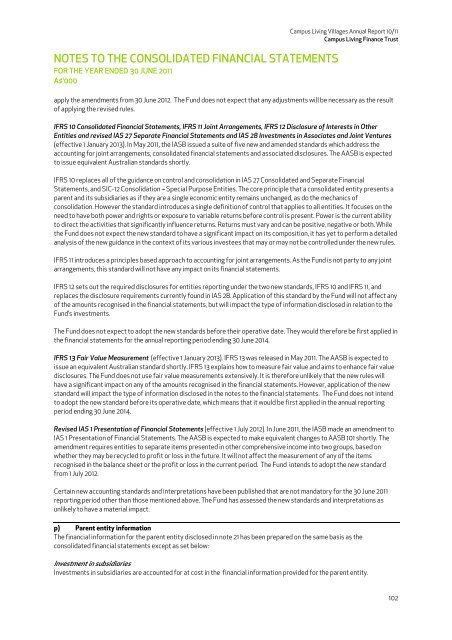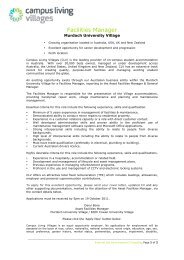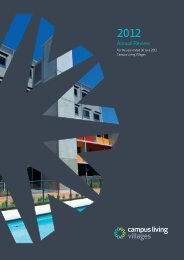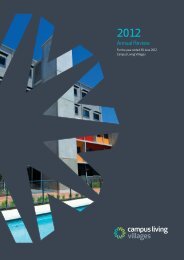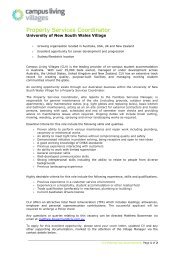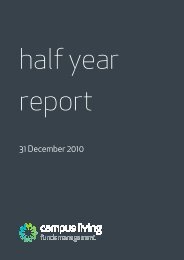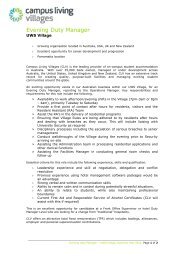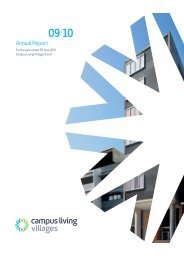Annual Report 10/11 - Campus Living Villages
Annual Report 10/11 - Campus Living Villages
Annual Report 10/11 - Campus Living Villages
You also want an ePaper? Increase the reach of your titles
YUMPU automatically turns print PDFs into web optimized ePapers that Google loves.
NOTES TO THE CONSOLIDATED FINANCIAL STATEMENTS<br />
FOR THE YEAR ENDED 30 JUNE 20<strong>11</strong><br />
A$’000<br />
<strong>Campus</strong> <strong>Living</strong> <strong>Villages</strong> <strong>Annual</strong> <strong>Report</strong> <strong>10</strong>/<strong>11</strong><br />
<strong>Campus</strong> <strong>Living</strong> Finance Trust<br />
apply the amendments from 30 June 2012. The Fund does not expect that any adjustments will be necessary as the result<br />
of applying the revised rules.<br />
IFRS <strong>10</strong> Consolidated Financial Statements, IFRS <strong>11</strong> Joint Arrangements, IFRS 12 Disclosure of Interests in Other<br />
Entities and revised IAS 27 Separate Financial Statements and IAS 28 Investments in Associates and Joint Ventures<br />
(effective 1 January 2013). In May 20<strong>11</strong>, the IASB issued a suite of five new and amended standards which address the<br />
accounting for joint arrangements, consolidated financial statements and associated disclosures. The AASB is expected<br />
to issue equivalent Australian standards shortly.<br />
IFRS <strong>10</strong> replaces all of the guidance on control and consolidation in IAS 27 Consolidated and Separate Financial<br />
Statements, and SIC-12 Consolidation -- Special Purpose Entities. The core principle that a consolidated entity presents a<br />
parent and its subsidiaries as if they are a single economic entity remains unchanged, as do the mechanics of<br />
consolidation. However the standard introduces a single definition of control that applies to all entities. It focuses on the<br />
need to have both power and rights or exposure to variable returns before control is present. Power is the current ability<br />
to direct the activities that significantly influence returns. Returns must vary and can be positive, negative or both. While<br />
the Fund does not expect the new standard to have a significant impact on its composition, it has yet to perform a detailed<br />
analysis of the new guidance in the context of its various investees that may or may not be controlled under the new rules.<br />
IFRS <strong>11</strong> introduces a principles based approach to accounting for joint arrangements. As the Fund is not party to any joint<br />
arrangements, this standard will not have any impact on its financial statements.<br />
IFRS 12 sets out the required disclosures for entities reporting under the two new standards, IFRS <strong>10</strong> and IFRS <strong>11</strong>, and<br />
replaces the disclosure requirements currently found in IAS 28. Application of this standard by the Fund will not affect any<br />
of the amounts recognised in the financial statements, but will impact the type of information disclosed in relation to the<br />
Fund’s investments.<br />
The Fund does not expect to adopt the new standards before their operative date. They would therefore be first applied in<br />
the financial statements for the annual reporting period ending 30 June 2014.<br />
IFRS 13 Fair Value Measurement (effective 1 January 2013). IFRS 13 was released in May 20<strong>11</strong>. The AASB is expected to<br />
issue an equivalent Australian standard shortly. IFRS 13 explains how to measure fair value and aims to enhance fair value<br />
disclosures. The Fund does not use fair value measurements extensively. It is therefore unlikely that the new rules will<br />
have a significant impact on any of the amounts recognised in the financial statements. However, application of the new<br />
standard will impact the type of information disclosed in the notes to the financial statements. The Fund does not intend<br />
to adopt the new standard before its operative date, which means that it would be first applied in the annual reporting<br />
period ending 30 June 2014.<br />
Revised IAS 1 Presentation of Financial Statements (effective 1 July 2012). In June 20<strong>11</strong>, the IASB made an amendment to<br />
IAS 1 Presentation of Financial Statements. The AASB is expected to make equivalent changes to AASB <strong>10</strong>1 shortly. The<br />
amendment requires entities to separate items presented in other comprehensive income into two groups, based on<br />
whether they may be recycled to profit or loss in the future. It will not affect the measurement of any of the items<br />
recognised in the balance sheet or the profit or loss in the current period. The Fund intends to adopt the new standard<br />
from 1 July 2012.<br />
Certain new accounting standards and interpretations have been published that are not mandatory for the 30 June 20<strong>11</strong><br />
reporting period other than those mentioned above. The Fund has assessed the new standards and interpretations as<br />
unlikely to have a material impact.<br />
p) Parent entity information<br />
The financial information for the parent entity disclosed in note 21 has been prepared on the same basis as the<br />
consolidated financial statements except as set below:<br />
Investment in subsidiaries<br />
Investments in subsidiaries are accounted for at cost in the financial information provided for the parent entity.<br />
<strong>10</strong>2


